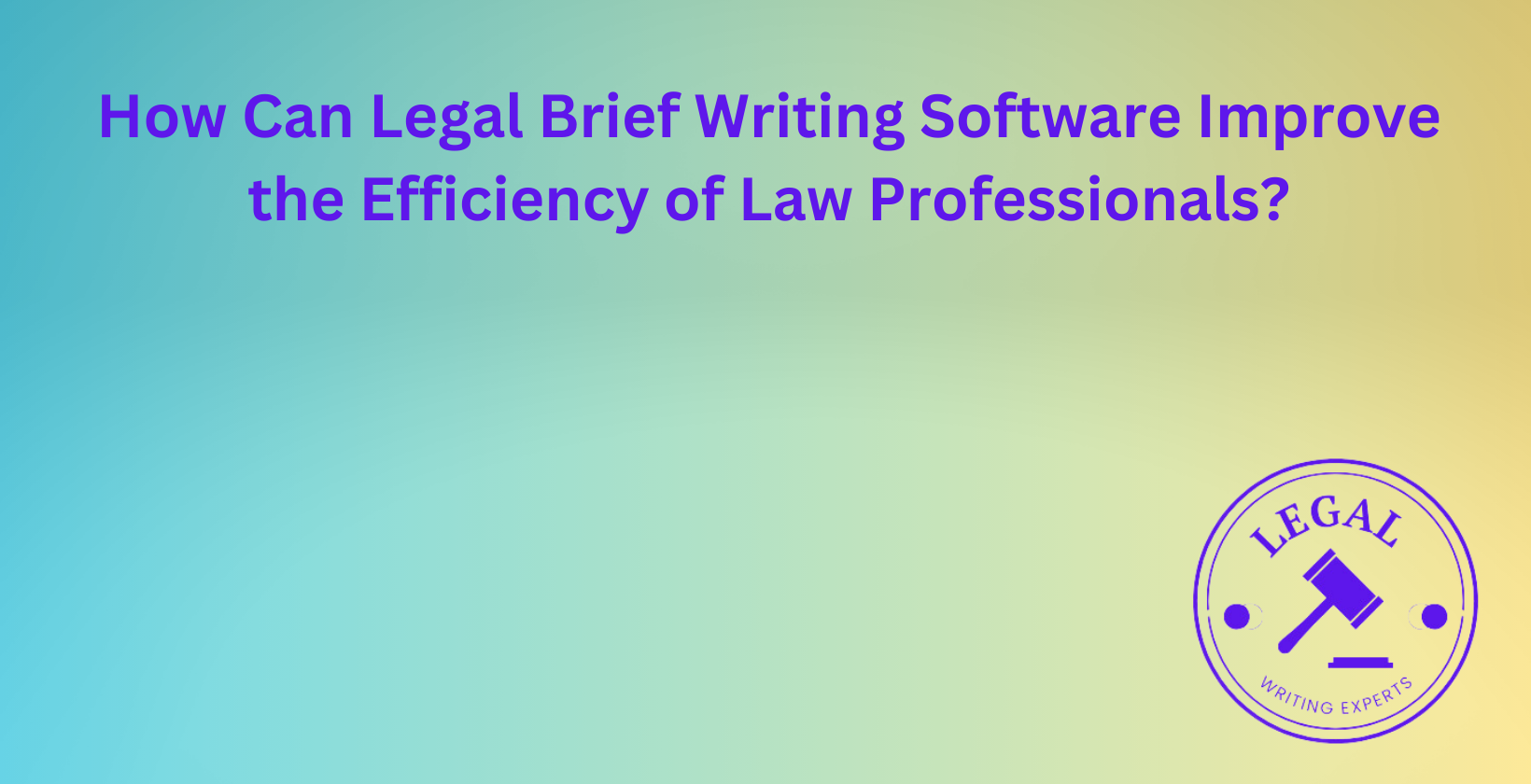How Can Legal Brief Writing Software Improve the Efficiency of Law Professionals?
Written by
Jessica E
November 20, 2024 · 8 min read

Legal brief writing software can significantly improve the efficiency of law professionals by streamlining the processes of research, drafting, editing, and collaboration. This software uses AI and machine learning to automate repetitive tasks, manage document formatting, and provide real-time updates to legal documents, saving time and improving accuracy. By simplifying document management, these tools enable law professionals to spend more time on complex legal analysis and client interactions. The software also allows for enhanced collaboration, letting multiple team members work on briefs simultaneously. Through predictive analytics, it can suggest relevant legal precedents and improve the quality of briefs, ultimately contributing to faster case preparation and a more organized workflow.
What is legal brief writing software?
Legal brief writing software is a specialized tool designed to aid lawyers and legal teams in drafting, formatting, and organizing legal briefs. It often includes features for document management, AI-driven research assistance, and formatting automation, allowing legal professionals to create briefs efficiently and consistently. The software focuses on reducing time spent on repetitive tasks and ensuring that all documents meet the required legal standards.
How does AI-powered legal brief writing software work?
AI-powered legal brief writing software works by leveraging artificial intelligence and natural language processing to assist with legal research, drafting, and document management. The software analyzes a database of legal cases and documents, identifying patterns and suggesting relevant precedents. It can quickly extract information from multiple sources, automate citation, and propose phrasing improvements, reducing the time needed to prepare briefs. Machine learning algorithms continuously enhance these features by learning from past cases and user inputs, making the software more accurate over time.
What are the key features of effective legal brief writing tools?
Effective legal brief writing tools have several key features, including automated formatting, citation management, and AI-driven research capabilities. These tools support collaboration, allowing multiple users to edit a document simultaneously. Predictive text and phrase suggestions, document management, and template libraries are additional features that streamline the brief-writing process. Integration with document management systems also enables seamless storage and retrieval of files, which is essential for maintaining organized case files.
How can automated brief formatting save time for lawyers?
Automated brief formatting can save time for lawyers by quickly applying consistent formatting standards to legal documents. By automating font selection, line spacing, headers, footers, and citation formats, the software reduces the manual time and effort required for document preparation. With this tool, lawyers no longer need to manually adjust the document to meet court submission standards, allowing them to focus more on case content rather than format specifics.
What are the benefits of using AI for legal research and analysis?
Using AI for legal research and analysis provides several benefits, including faster access to relevant case law, statutes, and precedents. AI algorithms can scan extensive databases in seconds, suggesting case references that may otherwise go unnoticed. AI also improves accuracy by reducing human error and helping legal professionals identify patterns and relationships across cases. AI-powered analysis tools help lawyers develop stronger arguments and improve the quality of their legal briefs through data-driven insights.
How do document management systems enhance legal writing efficiency?
Document management systems enhance legal writing efficiency by providing centralized storage and easy access to legal documents. These systems enable law professionals to organize briefs, research materials, and case files efficiently, reducing the time spent searching for documents. Document management features such as version control, tagging, and advanced search capabilities ensure that legal teams have quick access to the latest versions of documents, enhancing productivity and supporting collaboration.
What role does collaboration play in modern legal brief writing software?
Collaboration plays a crucial role in modern legal brief writing software by enabling multiple team members to work on a document simultaneously. This feature allows attorneys, paralegals, and other team members to contribute to briefs, providing real-time edits and feedback. Collaborative tools support a more cohesive drafting process, allowing legal teams to refine arguments, improve accuracy, and complete tasks more quickly than with traditional methods of document sharing.
How can AI tools improve the quality of legal briefs?
AI tools improve the quality of legal briefs by offering insights into relevant case law, optimizing language, and ensuring accuracy in citations. By using natural language processing, AI can suggest clear and concise phrasing, reducing ambiguity in legal arguments. AI also identifies possible errors and suggests improvements, enhancing readability and persuasiveness. Through automated research capabilities, AI tools provide reliable references and a solid foundation for the arguments within the brief.
What are the best AI-powered legal brief writing software options for small firms?
The best AI-powered legal brief writing software options for small firms include affordable and user-friendly tools that offer essential features without overwhelming functionality. Options typically feature AI-driven research, document management, and collaborative tools. They should integrate seamlessly with small-firm workflows, enhancing efficiency without requiring extensive setup or training. Tools that offer flexible pricing, cloud access, and secure data storage are particularly well-suited for small firms needing scalability.
How does legal brief writing software integrate with existing law firm workflows?
Legal brief writing software integrates with existing law firm workflows by connecting with document management systems, legal research databases, and client communication platforms. Integration allows lawyers to import and export files easily, synchronize document changes, and update clients efficiently. By integrating with project management tools, this software ensures seamless task tracking and collaboration within teams. This compatibility enables legal teams to enhance productivity without overhauling existing processes.
What security considerations should be addressed when using cloud-based legal writing tools?
Security considerations when using cloud-based legal writing tools include data encryption, user authentication, and compliance with legal data protection standards. Law firms must ensure that their chosen software provider offers strong encryption and regular security audits. Multi-factor authentication and role-based access control are critical for protecting sensitive information. Compliance with regulations such as the GDPR and HIPAA is essential to secure client data and maintain confidentiality.
How can predictive analytics enhance legal brief writing?
Predictive analytics enhances legal brief writing by providing insights into likely case outcomes based on historical data. It can identify trends in case law and judge rulings, helping lawyers anticipate potential challenges in their arguments. Predictive analytics tools assist attorneys in strengthening their briefs by using data-driven predictions and allowing them to tailor their arguments accordingly. This approach improves the likelihood of a favorable outcome by supporting evidence-based legal strategies.
What impact does natural language processing have on legal document drafting?
Natural language processing (NLP) impacts legal document drafting by improving readability, accuracy, and consistency in legal briefs. NLP technology analyzes and suggests revisions to ensure clear and concise language, reducing ambiguity and enhancing document quality. NLP-driven tools enable lawyers to produce more precise legal documents by detecting inconsistencies, redundant phrasing, and potential legal inaccuracies. By refining language, NLP tools help convey arguments more persuasively.
How can legal professionals overcome resistance to adopting new brief writing technologies?
Legal professionals can overcome resistance to adopting new brief writing technologies by highlighting the time and cost savings associated with these tools. Demonstrating how the technology reduces workload and improves efficiency can build buy-in among team members. Providing training sessions and resources helps ease the transition, and sharing success stories from similar firms can alleviate concerns. Supportive leadership and ongoing technical assistance are also essential to ensure a smooth adoption process.
What are the cost considerations for implementing legal brief writing software?
Cost considerations for implementing legal brief writing software include subscription fees, training costs, and potential data storage fees. Small firms may benefit from software with flexible payment plans and limited features, while larger firms might require comprehensive packages with more extensive functionalities. Firms should assess the long-term savings in time and efficiency when evaluating costs, as these tools often reduce billable hours spent on repetitive tasks.
How does AI-assisted brief writing affect the role of paralegals and junior associates?
AI-assisted brief writing changes the role of paralegals and junior associates by automating some research and drafting tasks. Although this reduces the manual workload, it allows these professionals to focus on higher-level tasks such as case analysis and client management. By automating routine work, AI tools enable paralegals and associates to contribute more strategically to legal projects, ultimately enhancing their skill development.
What ethical considerations arise when using AI for legal brief writing?
Ethical considerations when using AI for legal brief writing include data privacy, accuracy, and accountability. Lawyers must ensure that AI tools protect client information and produce reliable research results. Ethical concerns arise if attorneys overly rely on AI without verifying information accuracy. Law professionals need to balance AI efficiency with responsible usage to maintain ethical standards in client representation and legal accuracy.
How can legal brief writing software improve client communication and satisfaction?
Legal brief writing software improves client communication and satisfaction by enabling faster document preparation and more accurate reporting. Automated updates on case progress allow clients to receive timely information, enhancing transparency and trust. By streamlining document processes, this software helps law firms meet deadlines and improve case management, resulting in greater client satisfaction.
What future trends are expected in AI-powered legal writing tools?
Future trends in AI-powered legal writing tools include increased customization, enhanced predictive capabilities, and deeper integration with legal databases. Advancements in machine learning may allow AI to suggest more tailored legal arguments and predict case outcomes with higher accuracy. Integration with blockchain technology for secure document verification is another emerging trend. Overall, the future of legal writing tools will likely emphasize greater accuracy, security, and case outcome optimization.
Where can law firms hire legal writers experienced in using AI-powered brief writing software?
Law firms can hire legal writers experienced in using AI-powered brief writing software through the Legal Writing Experts platform. Legal Writing Experts offer resources for finding writers proficient in AI-based tools.
Meet the Author
Distinguished linguist at Legal Writing Experts
Jessica is an expert legal writer with a remarkable blend of legal knowledge and linguistic precision. She earned her Juris Doctor degree from Duke University, where she attended on a prestigious Law Faculty Merit Scholarship. At Duke, Jessica demonstrated her exceptional abilities by serving as an editor of the Duke Law Review.
After graduating, Jessica further refined her skills during a two-year appellate clerkship at a distinguished law firm in North Carolina. Throughout law school, she enhanced her research and writing expertise as a research assistant and writer for various legal firms. Jessica’s deep understanding of legal language and meticulous attention to detail make her an invaluable asset to our legal writing services.


